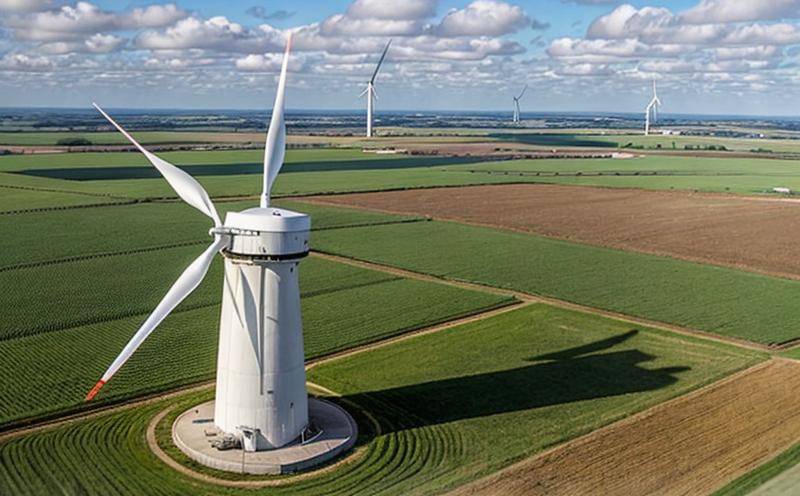ISO 1996-2 Environmental Noise Assessment of Wind Farms Testing
The ISO 1996-2 standard provides a comprehensive framework for the environmental noise assessment of wind farms. This internationally recognized method is crucial in ensuring that wind turbine operations comply with stringent noise regulations and contribute to a quieter environment, especially in residential and sensitive areas.
Wind turbines are significant contributors to renewable energy generation but can also generate audible noise levels that can affect local communities. The ISO 1996-2 standard aims to provide accurate measurement techniques for assessing the environmental impact of wind farm noise on human health and well-being. By adhering to this standard, wind farm operators not only ensure compliance with legal requirements but also enhance their reputation by demonstrating a commitment to sustainable practices.
The testing process begins with site selection. The location of the wind turbines can significantly influence the noise levels due to topography and environmental factors. Once the site is chosen, the next step involves setting up monitoring equipment at various points around the area where the turbines will be installed. This setup ensures that all potential sources of noise are captured accurately.
After deployment, continuous or periodic measurements are taken over a specified period. During this time, meteorological data such as wind speed and direction must also be recorded to correlate with noise levels. The ISO 1996-2 standard specifies the use of specific instruments like sound level meters and octave band analyzers for precise measurement.
The data collected from these measurements is then analyzed using statistical methods provided in the standard, which include calculating the day-night average sound level (Ldn). This parameter takes into account both daytime and nighttime noise levels, giving a comprehensive view of the overall impact on the environment. The analysis also involves comparing the measured values with established noise criteria to determine compliance.
The results of this testing are critical for several stakeholders including regulatory bodies, wind farm operators, and local communities. Regulatory bodies use these data to ensure that wind farms meet legal requirements set forth in environmental protection laws. Wind farm operators can use the findings to make informed decisions about turbine placement and operation parameters. Community members gain reassurance that their environment is being protected.
One of the key benefits of ISO 1996-2 testing lies in its ability to provide accurate and reliable data on wind farm noise levels. This accuracy ensures compliance with international standards, thereby reducing the risk of legal challenges or public opposition. Moreover, by adhering to this standard, operators can demonstrate their commitment to sustainability and responsible development practices.
Another significant benefit is the enhanced reputation that comes from conducting thorough environmental assessments. Positive publicity can lead to improved brand perception among stakeholders and potential investors. Furthermore, successful compliance with ISO standards can open up opportunities for international collaborations and partnerships in the renewable energy sector.
Benefits
The benefits of adhering to the ISO 1996-2 standard extend beyond mere compliance; they also offer substantial advantages across various aspects of wind farm operations. Firstly, it ensures that noise levels are consistently monitored and evaluated according to internationally recognized guidelines. This consistency helps in maintaining a high level of reliability when making decisions related to turbine placement and operation.
- Enhanced Compliance: Adhering strictly to ISO 1996-2 ensures full compliance with local, national, and international regulations regarding wind farm noise levels.
- Improved Reputation: Demonstrating a commitment to sustainable practices through rigorous environmental assessments can significantly enhance the reputation of both individual wind farms and the companies operating them.
- Increased Investor Confidence: Compliance with recognized standards like ISO 1996-2 can attract more investors by showcasing responsible business practices.
- Community Relations: By ensuring that noise levels are kept within acceptable limits, wind farms can improve their relationship with local communities, reducing the likelihood of public opposition.
In addition to these immediate benefits, long-term adherence to ISO 1996-2 testing helps in identifying potential issues early on. This proactive approach allows for timely adjustments in turbine design or operational parameters, which ultimately leads to more efficient and quieter wind farms.
Eurolab Advantages
At Eurolab, we are committed to providing the highest quality acoustic testing services that meet international standards. Our expertise in environmental noise assessment ensures that our clients receive accurate and reliable results every time. Here’s why partnering with us is advantageous:
- Experienced Professionals: Our team comprises highly skilled acousticians who possess extensive knowledge of ISO 1996-2 guidelines.
- State-of-the-Art Equipment: We utilize the latest acoustic measurement equipment, ensuring that all tests are conducted using top-tier technology.
- Comprehensive Reporting: Our reports not only include detailed measurements but also offer recommendations for enhancing compliance and reducing noise levels.
- Prompt Turnaround Times: We understand the importance of timely results and strive to deliver them within agreed-upon deadlines.
By choosing Eurolab, clients benefit from a combination of technical expertise, advanced equipment, comprehensive reporting, and efficient service delivery. This holistic approach ensures that our clients achieve optimal outcomes in their environmental noise assessments.





